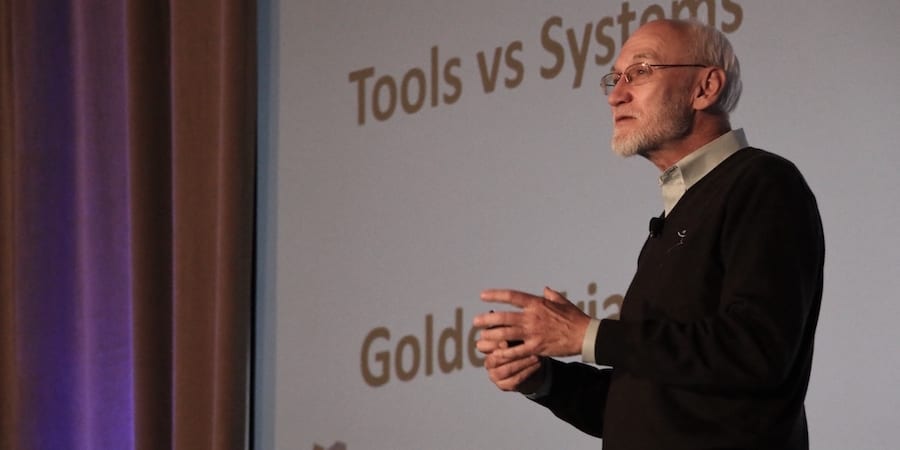
Learn about the BBC's improvement initiative Spark
INTERVIEW – The British Broadcasting Company (BBC) has been working with a lean-inspired improvement program that is gradually transforming the culture of the business – one creative idea at a time.
Interviewees: Adrian Ruth, Director, and Gemma Tomkinson, Manager of BBC Spark
Roberto Priolo: What is Spark?
Gemma Tomkinson: Spark is an in-house team that brings resources, skills, ideas and methodologies to help other parts of the BBC think differently about the way they work and change for the better.
RP: Was there a specific problem that Spark wanted to solve?
Adrian Ruth: The BBC had been given a tough saving target of 26%, which made it critical for us to increase our efficiency in any way we could. Spark – previously known as Efficiency Services Team – was initiated as one of the elements contributing to the savings (before it came in, people were given targets but no tools to achieve them), and to preparing the organization for a digital future. We wanted to see if a lean approach could help us to boost the efficiency of a creative media environment.
RP: What was the first Spark experiment you ran?
AR: Our pilot project was with a really important part of our portfolio, BBC Radio 1. The radio station was struggling to engage younger audiences: with so much competition coming from the likes of Spotify and Youtube, young people seem to be less and less interested in listening to the radio. The BBC, however, is a public broadcaster funded by a universal licence fee, and it is important that it provides something of value to everyone. Younger listeners turning off was a huge problem for us – after all, why would I pay a licence fee if I don’t get value from the service I am provided?
We hoped to make Radio 1 much more than just a radio station, but when we looked at its work, we noticed how the overwhelming focus was on listening – our plan was to expand the station’s remit to include “watching” and “sharing,” too.
We first looked at resource allocation, and decided to direct some of the funding to the activities we had been neglecting but that our customers found of value (watching and sharing). The result was extraordinary: the number of subscribers to Radio 1’s Youtube channel increased exponentially – they now have 3.5 million – and engagement on Facebook and Twitter became much more consistent. Now we look at reaching people from a more holistic point of view, rather than only focusing on radio listings figures.
RP: What did you learn from that first project?
AR: Many things. First of all, we became aware of the challenge of adapting the lean language to a media environment. We also learned to be conscious of the pace at which we were bringing in change: we realized that keeping momentum is important, but that we also have to give local teams the time to own the initiative and drive it forward. Finally, and most importantly, we understood that this could work! Delivering value in a creative environment is indeed possible.
RP: Was it really difficult to translate lean ideas into something that could work in a media environment, then?
AR: The core concepts of lean thinking (delivering value, minimizing waste, tackling problems, engaging people, and so on) translate in any environment, but it was perhaps a bit harder when we tried to tell people about SMED and other manufacturing-based tools. We don’t cling dogmatically to exclusively lean theory and we don’t feel we have to use all of the lean tools: we only deploy what makes sense for the BBC.
RP: How did you develop the skills of leadership and front-line staff?
GT: In 2014 we ran a pilot initiative called Lean for Leaders, which aimed at identifying and tackling the gaps people had in their knowledge of lean. We really wanted them to understand it, so we started reaching out to different areas of the BBC to get our people on the training program – the only prerequisite being that they had to have a need for change (a burning platform, so to speak).
Lean for Leaders was a success, but we soon noticed another problem: people coming to the training kept telling us that their bosses “just wouldn’t buy it.” Our answer to that was introducing Spark for Sponsors. These days, before we run a project in an area, we tell our sponsors (the leaders of each of the areas involved) about the methodology and explain to them what we intend to do. This way we have created a common language, and ensured that leaders are fully aware of what the teams will be doing to try and bring change about. Moreover, people going back to their areas after taking the Lean for Leaders course now find sponsors who are up to speed with fishbone diagrams, 5 whys, etc. Having leaders back the work of our front-line people is critical to the success of Spark, and therefore of the BBC.
RP: For the first two-to-three years, Spark relied on external consultants, but by 2015 its team was entirely internal to the BBC. How did the experience with consultants compare with having your own people running the show?
AR: We couldn’t have achieved what we did without the help we received from consultants, but there is no doubt there is a lot of value in having our own people, who know the BBC culture and have direct experience running programs, drive change. Wherever we go, we try to encourage our folks to use stories of change from within the BBC to get others on board: by comparison, the examples consultants used came from other industries and didn't carry the same weight.
When you have an in-house team that you have carefully recruited, things are different. We have really matured in our approach, but the external help we received has certainly been an important part of the overall journey: it gave us the initial confidence we needed to stand on our own feet.
GT: That we have matured is also clear by looking at the material we use to develop people, which has evolved since the consultants have left. Educational games are an example of this: one of them entails asking people to work together on writing and shooting a short (spoof) news report. Naturally, people working in a media organization will be able to relate more to this sort of example than they will to one coming from a different sector.
RP: In your minds, what were the projects that best showed the impact of Spark?
AR: A great one was the transformation of Songs of Praise – a religious show that presents Christian hymns and church services. This was a very traditional format that first launched in 1961. To tackle declining audience figures (the main reason being the advanced age of the average viewer), we decided to re-launch the program in a new format, making it more topical and diverse. The team had been used to creating episodes in the same way for decades, and at first it was a bit difficult for them to entirely rethink the show. Spark brought visual management to them, and that really energized them. The new format came out and started to make the headlines: we had, for example, a feature on gay marriage and a report from the “Jungle,” the migrant camp in Calais.
Projects don’t have to be about saving money: this one was about changing what a program offers to make it more interesting and creative. The team did a great job, and they are now making inroads into engaging younger people through Facebook and Twitter.
GT: My personal favorite is the local news project, which started in the South West as an attempt to increase the amount of original journalism we did and, once again, engage younger audiences by boosting our multi-platform presence. We wanted to ensure that each story would be on more than one platform – ideally on all three (TV, radio, and online). The South West team also wanted to implement Local Live (a platform introduced by the BBC that is based on a feed similar to Twitter – great for live coverage of developing and breaking news), but had no money to hire new people. So they found ways to free up staff and reinvest their time in producing original journalism and multi-platform content.
The project went so well that the BBC decided to roll it out in all regions. At that point we could have simply replicated the same initiative everywhere else, but what we wanted was for each regional team to be empowered to come to us and share the ideas they had to improve the work. They came up with amazing things, like the Magic Minute – a new feature that allows the online team to capture, at the press of a button, the last bit of a radio program to immediately share a sound bite on all platforms.
RP: Your story is testament to the fact that lean doesn't stifle creativity. Actually, it is quite the opposite!
AR: Indeed – what we do with Spark is freeing up time so that people can develop and work on the great ideas they have.
THE INTERVIEWEES


Read more


INTERVIEW – In this must-read Q&A, our editor sits down with lean guru John Shook to discuss the meaning of failure, the nature of innovation, and the resilience of our movement.


FEATURE – Aligning supply flows with demand is crucial to success, but it can be complicated. Lean Thinking can help us identify the strategy and sequence of activities that we need to make it a reality.


CASE STUDY – The reimbursement department of the largest independent insurance company in Brazil has brought together lean and digitalization to improve its service to customers.


COLUMN - For those working in the I.T. world, identifying waste can be tricky. However, starting by tackling over-production will help you to eliminate every other form of waste.

